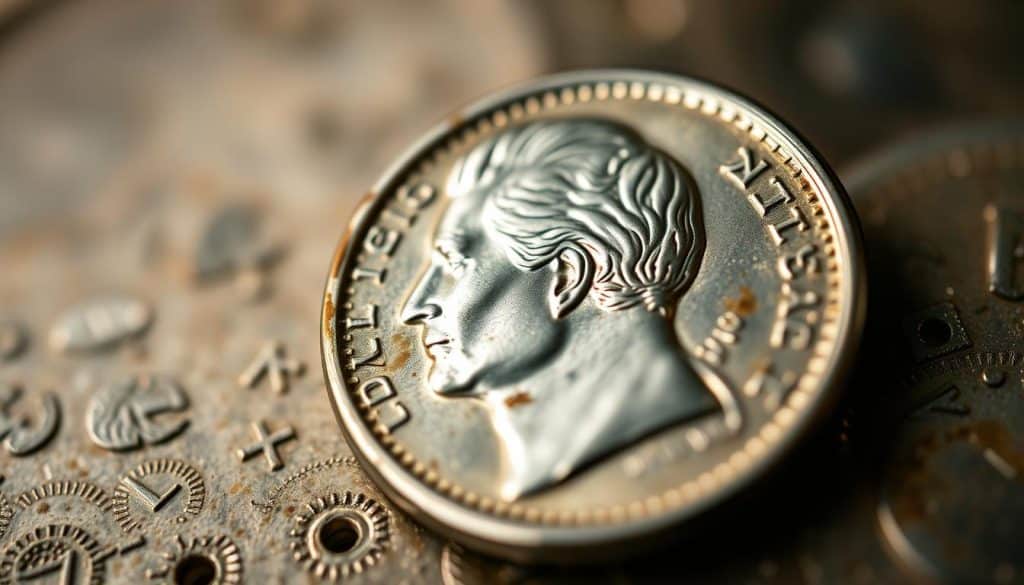The nickel coin has been a staple of American currency for over 150 years1. This small piece of metal has a fascinating history. It’s evolved into an essential part of the US economy and a prized item for coin collectors.
The nickel’s significance mirrors recent special coin releases. For example, the Royal Mint’s Paul McCartney collection shows how coins capture cultural moments. These tiny metal discs continue to hold our interest and imagination.
Key Takeaways
- The nickel coin has been a part of American currency for over 150 years.
- Nickel coins have evolved over time, becoming an integral part of the US economy.
- Nickel coins are highly collectible, with certain rare and valuable variants.
- The cultural and historical significance of nickel coins is similar to that of the recent Royal Mint’s Paul McCartney coin collection.
- The nickel coin continues to play an important role in American daily transactions and the numismatic world.
Introduction to the Nickel Coin
The nickel coin has been crucial to American commerce for over a century. It’s a five-cent piece in U.S. currency. The Jefferson nickel, introduced in 1938, is the current design.
What is a Nickel Coin?
A nickel is a five-cent piece in the U.S. monetary system. It’s one of the few coins still in circulation today. The copper-nickel alloy gives the coin its silver-gray look and toughness.
Importance of the Nickel in American Currency
The nickel has been key to American currency since the 19th century. It reflects American history and culture, similar to special coin collections honoring music legends.
The nickel’s constant use in daily transactions shows its importance in the U.S. economy.
“The nickel has been an integral part of American commerce for over a century, serving as a reflection of our nation’s history and culture.”
The History of the Nickel Coin
The nickel coin has a rich history dating back to the mid-19th century. It replaced the silver half dime and has evolved over time. The five-cent piece reflects changing artistic tastes and economic conditions in the United States.
Origins of the Nickel Coin
The nickel coin entered circulation in 1866, marking a shift in American currency. Unlike its silver predecessor, the nickel was minted from a copper-nickel alloy, providing a more durable and cost-effective alternative. It quickly gained popularity and became essential for everyday transactions.
Evolution Over Time
The nickel has undergone several design changes throughout its history. One iconic version was the era saw a change in composition to conserve resources.
The nickel’s evolution mirrors the changing times and tastes of the American people. It has adapted and remained resilient through various economic conditions.
Like modern coin collections, such as the Paul McCartney series, the nickel captures cultural essence2. It has become a cherished symbol of the nation’s financial heritage.
“The nickel has witnessed several design changes, each of which has left an indelible mark on its history.”
Different Types of Nickel Coins
US nickel coins boast a fascinating history. The Buffalo Nickel stands out among them. It features a Native American and an American bison on its sides.
This design, used from 1913 to 1938, broke from tradition. It showcased artistic flair and historical importance in US nickel design3.
The Jefferson Nickel debuted in 1938. It shows Thomas Jefferson and his home, Monticello. This design has lasted over 80 years, making it a coin history record-holder.
The Jefferson nickel reflects America’s respect for its founders3.
Other notable designs exist too. The Wartime Nickel (1942-1945) had a unique metal mix. It sported a large “P” mint mark to set it apart.
Recent special editions honor events and people. One example is the 2018 coin featuring musician Paul McCartney3.
These diverse designs highlight the nickel’s importance. It’s both a useful currency and an artistic canvas. The nickel’s rich variety fascinates collectors and coin experts.
It preserves the legacy of this modest yet iconic American coin3.
| Nickel Coin Variant | Design | Year Introduced |
|---|---|---|
| Buffalo Nickel | Native American on obverse, American bison on reverse | 1913-1938 |
| Jefferson Nickel | Thomas Jefferson on obverse, Monticello on reverse | 1938-present |
| Wartime Nickel | Altered composition due to metal shortages, “P” mint mark | 1942-1945 |
| Paul McCartney Commemorative | Featuring the musician | 2018 |
US nickel designs show the coin’s artistic and cultural value. From Buffalo to Jefferson, each style reflects changing times. Special editions honor important people and events3.
Minting Process of Nickel Coins
Nickel coins are made of a copper-nickel alloy. This mix contains 75% copper and 25% nickel4. Minting these coins involves several steps to ensure quality and consistency.
Materials Used
Nickel coins are primarily made from a copper-nickel alloy4. This blend creates a durable, corrosion-resistant coin. It also gives the coin its unique color, weight, and ability to withstand wear.
The Production Process
Minting nickel coins starts with preparing the metal. Next comes blanking, annealing, upsetting, and striking4. These steps ensure each coin meets the U.S. Mint’s strict standards.
The Royal Mint’s Minting Experience Center lets visitors see coin production up close4. It has six stations showing different minting stages. Guests can interact with each step, from metal prep to final striking.
Coins made at the Center are 38.4 mm wide and 2.75 mm thick4. A 185-ton force embosses the design. Each coin gets a unique 4-digit laser-engraved serial number4.
The Royal Mint creates special edition coins, like the McCartney collection4. These coins celebrate important events and showcase the mint’s craftsmanship. They highlight the skill and versatility of the mint’s technicians.
The Royal Mint leads in coin and currency expertise. Their Minting Experience Center offers a unique learning opportunity4. Visitors discover the history, materials, and methods behind nickel coin creation.
“The minting process is a true testament to the precision and craftsmanship that goes into every coin we produce. From the carefully selected metals to the intricate striking, each nickel is a work of art.”
– Royal Mint Spokesperson
How to Identify Nickel Coins
US five-cent pieces, or nickels, have distinct features that collectors should know. They can be spotted by their looks and mint marks5.
Visual Characteristics
Nickels show Thomas Jefferson’s face on the front side. The back usually has Monticello, Jefferson’s famous home. These coins are 21.21 mm wide and weigh 5 grams5.
Mint Marks and Their Significance
Mint marks are tiny letters on nickels showing where they were made. They’re often on the front of the coin. These marks help collectors know a coin’s rarity5.
Mint marks are crucial for figuring out a nickel’s value. They’re like special features on rare coins, such as McCartney editions5.
| Mint Mark | Location |
|---|---|
| P | Philadelphia |
| D | Denver |
| S | San Francisco |
| W | West Point |
Learning about nickel looks and mint marks helps collectors spot valuable coins. This knowledge boosts your skill in identifying US five-cent pieces5.
“Coin collecting is a fascinating hobby that allows us to uncover the stories hidden within each US five-cent piece.”
Knowing nickel coin details can make collecting more fun. It helps you spot special pieces in American currency5.
The Role of Nickel in Collecting
Nickel coins boast high numismatic value, especially those with rare dates and mint marks3. Collectors prize them for their history and design variations3. Like McCartney coins, some nickels command high prices due to rarity or historical importance6.
Numismatic Value
Nickel coin collectors treasure these pieces for their unique traits and historical significance3. Rare, well-preserved specimens can sell for impressive sums at auctions and in the market.
The most valuable nickels often date back to the early 1900s3. Enthusiasts seek coins with special designs, mintage errors, and other unique features.
Popularity Among Collectors
Nickel coins maintain a strong following among collectors who appreciate their rich history3. The Buffalo and Jefferson Nickels offer chances to explore American coinage evolution3.
The Royal Mint’s McCartney coin collection shows nickels’ enduring appeal in numismatic collecting6. These coins feature designs by the iconic musician himself.
| Coin | Value |
|---|---|
| 2-ounce gold proof McCartney coin | 5,890 pounds |
| 5-kilogram signed gold McCartney coin | 250+ hours to make |
| 4 silver 5-kilogram McCartney coins | Auctioned alongside the gold coin |
This table highlights the numismatic value of the McCartney coin collection6. It shows the craftsmanship and rarity that fascinate collectors.
“The design process for the coin involved McCartney himself, ensuring the authenticity and appeal of this numismatic offering.”
Nickel coins’ history and design evolution continue to captivate collectors worldwide36. The pursuit of these valuable five-cent pieces remains a passionate hobby for many.
The Value of Nickel Coins Today
Nickel coins can be worth more than their face value. Their value depends on condition, rarity, and metal content. Rare and collectible nickels often fetch higher prices in the market.
Current Market Value
Several factors influence the market value of nickel coins. Common Jefferson nickels usually hold their face value or a slight premium. Their worth ranges from $0.05 to $0.25, based on condition.
However, rare and historically significant nickel coins can be worth significantly more.
Factors Influencing Nickel Prices
- Rarity: The scarcity of a particular nickel coin, often determined by its mintage numbers, is a significant factor in its market value.
- Condition: The overall condition and preservation of a nickel coin play a crucial role in its valuation, with higher-grade specimens commanding higher prices.
- Historical Significance: Nickels with unique designs, such as the Buffalo nickel or the McCartney collection, can be highly sought after by collectors due to their cultural and historical importance.
- Collector Demand: The level of interest and competition among numismatists and coin collectors for a particular nickel coin can also influence its market price.
These factors help determine a nickel’s true value in today’s market. Rarity, condition, and historical significance are key in assessing worth.
Collectors and investors can make smart choices when buying these valuable American currency pieces.
“The value of a nickel coin can range from its face value to hundreds or even thousands of dollars, depending on its rarity and condition. Collectors and enthusiasts seek out these small pieces of history, driven by a passion for preserving the legacy of American coinage.”
The Impact of Nickel Coins on the Economy
The US nickel has been vital in everyday economic transactions. These five-cent pieces have facilitated countless exchanges, from vending machines to parking meters. Their economic relevance now extends beyond their face value, impacting industries and shaping market trends.
Historical Economic Significance
Nickels have been a staple of American commerce for years. They’ve served as a reliable medium of exchange, making small-scale purchases possible. These coins have remained a steadfast part of the US monetary system.
Current Economic Relevance
The economic impact of nickels has changed with the financial industry. Production costs sometimes exceed their face value, raising questions about their future. This is similar to how special edition coins contribute to the economy through collector markets.
Nickels still play a crucial role in daily transactions. They’re especially important in vending and parking meter industries. The demand for reliable currency has increased with growing interest in the Indian securities market.
The Indian options market has grown significantly over the last five years. This expansion has highlighted the importance of nickels as a stable medium of exchange. They help facilitate smooth financial operations and foster economic development.
The role of nickels remains a topic of ongoing discussion. Their future may be uncertain, but their impact is undeniable. Nickels have proven to be a resilient part of the American financial system.
These coins have adapted to changing times and maintained their relevance. They continue to play a crucial role in the ever-shifting world of commerce7.
Collecting and Investing in Nickel Coins
New nickel coin collectors can start by focusing on specific series or years. Understanding coin grading systems is key for valuing your collection accurately8. Investors should consider rarity, condition, and historical significance when building their portfolio8.
This approach is similar to collecting special editions, like the McCartney collection. It balances personal interest with potential value growth.
Tips for New Collectors
- Begin by targeting specific nickel coin series or years that pique your interest
- Learn about the different grading systems used to evaluate coin condition and value
- Research the rarity, historical significance, and market demand for different nickel coin types
- Start small and gradually build your collection based on your budget and goals
Grading and Valuation
Grading nickel coins accurately is crucial for determining their market value. Coin grading services use standard scales to assess surface condition, strike quality, and visual appeal9.
Understanding these systems helps new collectors make smart decisions when buying and valuing their coins9.
“Investing in rare and well-preserved nickel coins can be a rewarding hobby and a potentially lucrative venture, but it requires diligent research and a keen eye for detail.”
Combining a love for numismatics with smart collecting strategies can lead to a valuable coin portfolio89. This approach brings both enjoyment and potential financial rewards.
Rare Nickel Coins and Their Worth
Certain rare nickel coins can fetch incredible prices at auction. These five-cent pieces captivate numismatists and investors alike. They’re willing to pay record-breaking sums for these unique treasures.
Examples of Rare Nickels
The 1913 Liberty Head nickel is one of the most sought-after rare coins. Only five of these coins are known to exist, making them immensely valuable.
In 2018, one of these rare nickels sold for $4.56 million at auction. This set a new record for the most expensive nickel ever sold.
Another prized rarity is the 1937-D Three-Legged Buffalo nickel. Only a few hundred were minted due to a production error.
Record Prices at Auctions
Rare nickel coins are prized for more than just their historical significance. Their scarcity and collectibility have driven auction prices to unprecedented heights.
Besides the record-setting 1913 Liberty Head nickel, other rare nickels have also fetched multi-million-dollar prices. For instance, a 1938-D Buffalo nickel in exceptional condition sold for $3.75 million in 2018.
| Rare Nickel Coin | Auction Price | Year Sold |
|---|---|---|
| 1913 Liberty Head Nickel | $4.56 million | 2018 |
| 1938-D Buffalo Nickel | $3.75 million | 2018 |
These exceptional nickels have become highly sought-after collectibles. Auction houses and collectors compete fiercely to acquire these numismatic treasures. Their value continues to rise, making them a unique investment opportunity.
Caring for Nickel Coin Collectibles
Keeping your nickel coin collectibles in top shape is vital. Good care ensures these rare treasures last for ages. Let’s explore how to preserve your coins properly.
Best Practices for Preservation
Follow these tips to keep your nickel coins in great condition:
- Handle coins with care, avoiding direct skin contact. Use cotton gloves or clean, soft-tipped tweezers to minimize oils and fingerprints10.
- Store coins in protective holders, such as coin capsules or archival-quality plastic sleeves, to shield them from environmental factors11.
- Keep coins in a cool, dry place, away from direct sunlight, moisture, and extreme temperature fluctuations. Consistent environmental conditions are key12.
- Consider investing in a coin cabinet or display case to showcase your collection while maintaining optimal preservation10.
Common Mistakes to Avoid
Poor handling and storage can harm your nickel coin collectibles. Watch out for these errors:
- Avoid cleaning coins with abrasive materials or harsh chemicals, as this can damage the surface and mint condition11.
- Do not store coins in open-air environments, such as plastic bags or envelopes, as they can trap moisture and cause corrosion12.
- Refrain from exposing coins to strong magnetic fields, as this can alter their metallic composition and appearance10.
Good practices help your nickel coins keep their worth. By avoiding mistakes, you protect their history and value. Your collection can last for many years to come.
| Characteristic | Rating |
|---|---|
| Accurate description | 4.910 |
| Reasonable shipping cost | 5.010 |
| Shipping speed | 4.910 |
| Communication | 5.010 |
“Proper coin preservation is not only about maintaining the physical condition, but also safeguarding the historical and monetary value of these numismatic treasures.” – Coin Collecting Expert
These tips will help keep your coins in great shape. Your nickel collection can stay valuable and historic for future generations12.
Conclusion: The Legacy of the Nickel Coin
The nickel coin’s legacy in American currency is truly remarkable. It showcases historical significance and cultural impact. This article explores the history and value of Jefferson nickels.
These coins are prized for their rarity and unique features. Their historical significance contributes to high market prices.
The Future of Nickel Coins in Currency
The nickel’s fate in American currency is uncertain. However, its legacy as a collectible and symbol remains strong. Special edition coins like the McCartney collection have boosted cultural heritage13.
The financial world is changing rapidly. Bitcoin spot ETFs have gathered $100 billion since launch. Analysts predict cryptocurrency will hit $200,000 by late 202513.
Despite these changes, the nickel’s importance in American currency will persist. Its role may shift, but its significance endures.
Reflection on Historical Significance
The nickel coin is more than just a daily transaction tool. It’s a tangible link to America’s past. This small coin has made a big impact on our history.
Rare and valuable Jefferson nickels remind us of the coin’s enduring significance. They highlight its role in shaping America’s numismatic heritage.
As currency evolves, the nickel’s legacy will continue to inspire. It will remain cherished by coin enthusiasts for generations to come.







